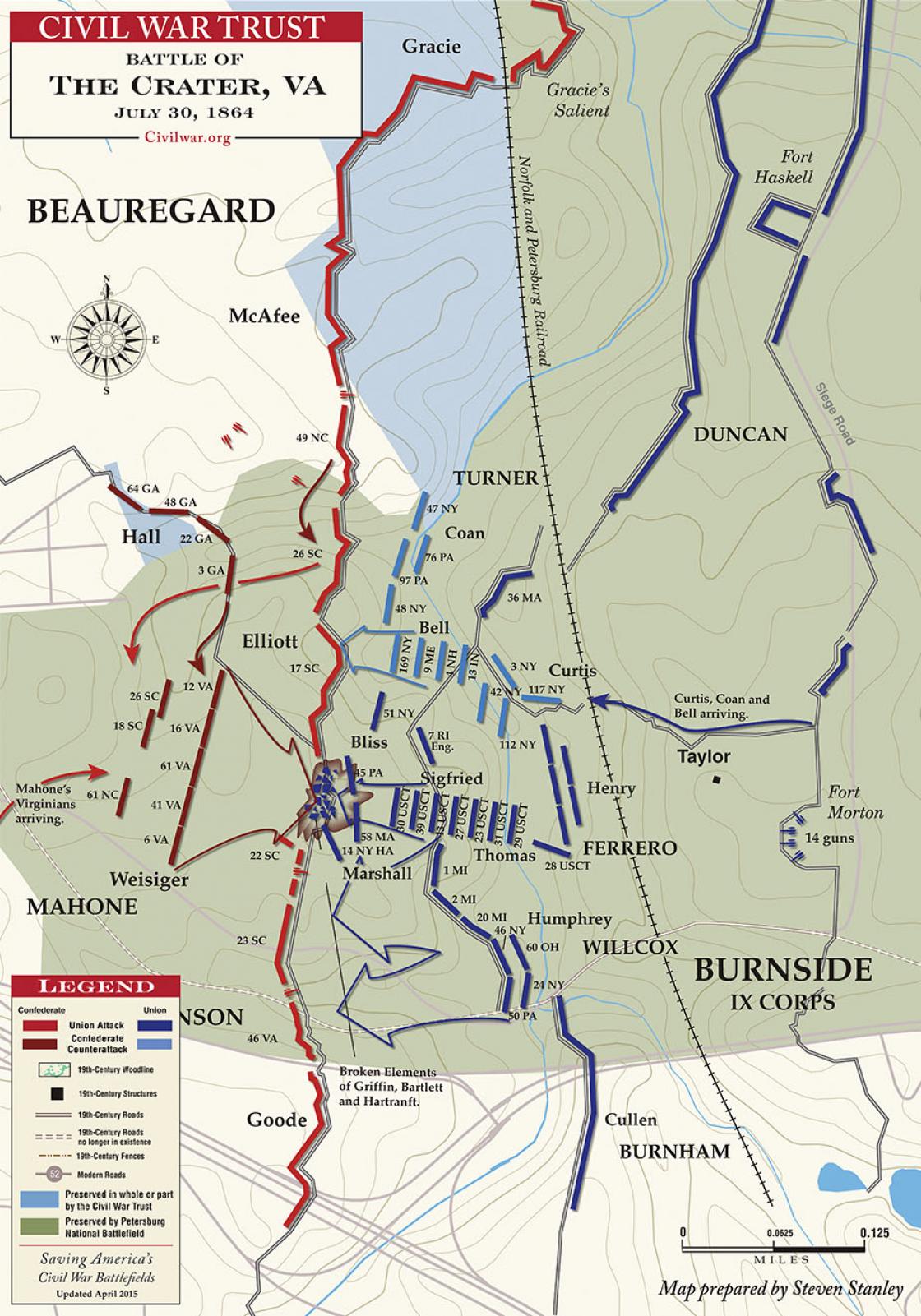About Publications Library Archives
heritagepost.org

Preserving Revolutionary & Civil War History

Preserving Revolutionary & Civil War History

July 13, 1864, At the Battle of the Crater, the Union’s ingenious attempt to break the Confederate lines at Petersburg, Virginia, by blowing up a tunnel that had been dug under the Rebel trenches fails. Although the explosion created a gap in the Confederate defenses, a poorly planned Yankee attack wasted the effort and the result was an eight-month continuation of the siege.
The bloody campaign between Union General Ulysses S. Grant and Confederate Robert E. Lee ground to a halt in mid-June, when the two armies dug in at Petersburg, south of Richmond. For the previous six weeks, Grant had pounded away at Lee, producing little results other than frightful casualties. A series of battles and flanking maneuvers brought Grant to Petersburg, where he opted for a siege rather than another costly frontal assault.
In late June, a Union regiment from the 48th Pennsylvania Infantry began digging a tunnel under the Rebel fortifications. The soldiers, experienced miners from Pennsylvania’s anthracite coal regions, dug for nearly a month to construct a horizontal shaft over 500 feet long. At the end of the tunnel, they ran two drifts, or side tunnels, totaling 75 feet along the Confederate lines to maximize the destruction. Four tons of gunpowder filled the drifts, and the stage was set.
Union soldiers lit the fuse before dawn on July 30. The explosion that came just before 5:00 a.m. blew up a Confederate battery and most of one infantry regiment, creating a crater 170 feet long, 60 to 80 feet wide, and 30 feet deep.
As one Southern soldier wrote
“Several hundred yards of earth work with men and cannon was literally hurled a hundred feet in the air.”
Another account, Regis de Trobriand, Four Years with the Army of the Potomac, trans. George K. Dauchy (Boston: Ticknor and Co., 1889), 618; Stephen M. Weld, “Petersburg Mine”, Papers of the Military Historical Society of Massachusetts, vol. 5 no. 10 (Read Before the Society March 27, 1882): 209
At 4:45 a.m. the earth below the Rebel strongpoint bulged and broke, and an enormous mushroom cloud, “full of red flames, and carried on a bed of lightning flashes, mounted towards heaven with a detonation of thunder.” The explosion blasted a crater 130 feet long, 75 feet wide, and 30 feet deep, with sheer walls of jagged clay. The bottom was “filled with dust, great blocks of clay, guns, broken carriages, projecting timbers, and men buried in various ways . . . some with their legs kicking in the air, some with the arms only exposed, and some with every bone in their bodies apparently broken.”
However, the Union was woefully unprepared to exploit the gap. The Yankees were slow to exit the trenches, and when they did the 15,000 attacking troops ran into the crater rather than around it. Part of the Rebel line was captured, but the Confederates that gathered from each side fired down on the Yankees. The Union troops could not maintain the beachhead, and by early afternoon they retreated back to their original trenches.
This failure led to finger pointing among the Union command. General Ambrose Burnside, the corps commander of the troops involved, had ordered regiments from the United States Colored Troops to lead the attack, but the commander of the Army of the Potomac, George G. Meade, nixed that plan shortly before the attack was scheduled. Fearing that it may be perceived as a ploy to use African-American soldiers as cannon fodder, Meade ordered that white troops lead the charge. With little time for training, General James H. Ledlie was left to command the attack.
Most of the eyewitness evidence of the Crater massacre comes from Confederate sources. This is because, on balance, official policy and public opinion approved of the murder of Black troops, so that Confederate soldiers made no effort to conceal the work of massacre—rather, they took pride in describing it. As a further indication of official attitudes, on the day after the battle Confederate military authorities had the IX Corps prisoners—black and white, officers and men, wounded and whole—paraded through the streets of Petersburg to be insulted and humiliated by the citizens—an abuse of prisoners unprecedented in American warfare.
The Battle of the Crater was a hugely disappointing and demoralizing defeat. The opportunity presented by Grant’s successful diversion north of the James and the explosion of the mine was one that would never recur. Burnside and Ledlie were sacked, several subordinate commanders reprimanded. The army and much of the press blamed the Black troops for the breakdown of the infantry attack, although their performance had actually been the best of any of the engaged units. They seized more critical ground, captured more enemy troops, advanced further and suffered heavier losses than any other unit. Ledlie’s white division, which was engaged for nine hours, suffered 18% casualties. The Fourth Division, engaged for less than half that time, lost 31%; and because so many of their wounded were murdered, their ratio of killed to wounded was more than double that of any Federal unit.
The Union armies lost approximately 3,800 men, killed, wounded, missing and captured, at the Crater. Confederate losses are harder to specify, but were between 2,300 and 2,500 at a minimum. However, when the casualties of the Deep Bottom diversion are added in (438 Union, 635 Confederate) the disparity shrinks. Grant could better afford his 4,000+ casualties than Lee his 3,100.
The Battle of the Crater essentially marked the end of Burnside’s military career, and on April 15, 1865, he resigned from the army.